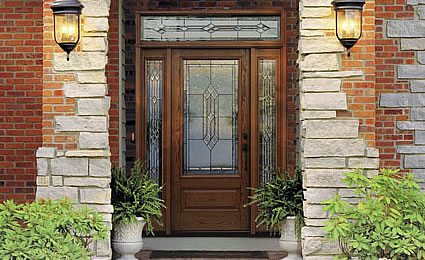It is summertime and you have been out mowing your lawn and planting flowers throughout your yard and you happen to notice that your front door to your home has lost its appeal. Finding the right front door for your home is tough. For starters, entry doors must be durable enough to withstand wind, rain, scorching sun, and would-be intruders, yet handsome enough to make a good first impression. Unfortunately, meeting those needs is a tall order for many front doors.
Whether we are describing your current front door or you just want to trade a solid door for one with glass panels that offer more light, you’ll find there are plenty of options available. There are new wood doors that resist the elements better than earlier versions, as well as metal and fiberglass ones that look like wood but provide greater security and often cost less. The sky is the limit. Finding the right door is where it gets tricky.
Most manufacturers offer dozens of door styles, and you’ll find a broad selection at lumberyards, home centers, and door dealers. Some manufacturers let you specify the types of panels and glass options you want. But these doors have to be specially ordered and may take two to eight weeks for delivery. (By then, summer is over). At Better Way Home Improvement, we are going to try to narrow the search and help you select the right front door for your home.
SELECTING THE RIGHT MATERIAL FOR YOUR FRONT ENTRANCE DOOR
Perhaps the most important decision when selecting your front door is the type of material your door is made of. Most manufacturers combine several materials; for example, many fiberglass and steel doors have wood frames. It’s the surface material that most affects appearance, durability, security, and price.
Wood doors are the most common.
Versatility and beauty are their strong suit. Natural-finish stock and custom wood doors come in oak, cherry, walnut, mahogany, maple, fir, and pine. You’ll also find paint-grade doors in several softwood varieties, such as pine and western hemlock. Many stock wood doors are a sandwich of wood-veneer skins over an engineered-wood core. This configuration minimizes the expansion and contraction that cause warping. At about $200 or so to start, they’re a low-cost alternative to solid-wood doors. Look for tough, furniture-grade veneers at least 1/16 inch thick; anything thinner damages too easily.
A steel door is your best bet if security and durability are top priorities.
Steel units are stronger than wood or fiberglass doors, and they won’t crack or warp. Any dents or dings on these doors can be pulled and puttied with an auto-body repair kit. Steel doors can be painted to any color that suits you and best compliments your home.
Steel doors are the most affordable. Prices start at about $150 for a 3-foot-wide x 6-foot 8-inch-tall paneled door without hardware or glazing. All steel doors have an inner frame made of wood or, for greater strength, steel. The cavities within the frame are filled with high-density foam insulation. Premium doors typically have a 24-gauge skin and a steel frame, though some offer heavier-gauge steel (represented by a lower number). The surface usually is smooth or has an embossed wood-grain pattern. Most steel doors are coated with a baked-on polyester finish that requires periodic repainting.
Fiberglass-composite doors are another affordable, tough and maintenance-free option.
They are a smart choice for harsh or humid climates. They mimic the look of wood with wood-grain texturing and can be stained to match oak, cherry, walnut, and a variety of other woods. Beneath their molded surface is a framework of wooden stiles and rails, including wood edges for the lock set. Voids in the framework are filled with polyurethane-foam insulation. Fiberglass-composite doors carry long warranties.
Aluminum doors, like steel units, use an insulation core covered by a metal skin.
Unlike other door systems, however, aluminum versions are sold exclusively through dealers. Each is custom-built to your opening. Manufacturers offer all types of options. Aluminum doors come in dozens of styles and colors, with smooth or wood-grain finishes. They have a baked-on enamel finish, so they never need painting and won’t rust — which explains the 20-year warranties that are common. You can also match the color and style of your door with an aluminum storm door. At prices that start at about $600, aluminum doors are the most expensive choice after solid wood.
Shopping for doors can be a confusing process. Better Way Home Improvement can help you choose the best options for your home. During our FREE consultation, we can suggest the best design, fit and functionality for your new entryway. Contact Better Way Home Improvement for your next front entrance door installation project. Visit our door installation page now to learn more.









